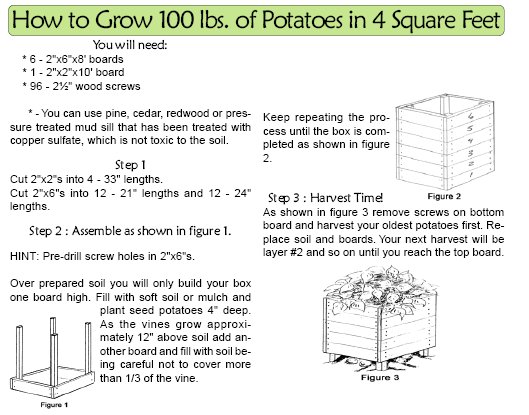Potato
From Allotments4All
Back to Main Page
Back to List of vegetables to grow
This was copied from the Thomas & Morgan (seed merchants) web site. Public domain.
CHITTING (Sprouting) PROCESS It is very important that your tubers are kept in a frost free area. Remove them immediately from their nets, spread them out in a cool, well ventilated place prior to sprouting (called 'chitting'). All seed potatoes, particularly Earliest and Second Earlies, can benefit from 'chitting' and the formation of strong 'chits' over several weeks gives faster growth when planted out and heavier crops. Use seed trays, shallow boxes or empty egg cartons to 'chit' your potatoes.You will notice that the immature 'chits' are all at one end (called the rose end). Place the rose end upwards. Keep in a cool, but frost free place in natural light. Sturdy 'chits' will form which should attain 25mm (1 in.) in length.
PLANTING Potatoes grow best in rich soil containing plenty of well rotted manure or compost (do not use fresh compost to minimise keeled slug problems) and do not lime the soil to minimise scab blemishes on developing tubers. Planting times are not critical and are dependant on weather, soil conditions and regional variations but below is a general guide. Use our specially blended, high potash Potato Fertiliser when planting.
POTATO FERTILISER Concerning application of the 3kg bag of pelleted, high potash fertiliser. This should be sufficient to plant 60 tubers, using 50g (just under 2oz) per tuber. Its application is a matter of persona] choice, and to a certain extent depends on the condition of your soil. You can incorporate 50g in each individual planting hole (as with any fertiliser it should not be in immediate contact with the tuber to avoid scorching), or you can incorporate 25g when planting and another 25g when first earthing up. If you plant in a trench instead of dibbing or using a trowel, then you can scatter the pellets along the trench or leave until you earth up.
AFTERCARE Most importantly protect emerging shoots from any frosts by carefully drawing soil over the shoots. Frost will blacken the shoots and delay production severely. First and Second Earlies particularly require plenty of water during prolonged dry weather especially when tubers are starting to form. Earth up regularly as the plants develop.
HARVESTING Start to harvest First Earlies as 'new potatoes' when plants commence flowering, although not all varieties freely flower or flower over an extended period. Therefore, a more reliable method is the number of weeks from date of planting. As a guideline, allow 10 weeks from planting for First Earlies, 13 weeks for Second Earlies, 15 weeks for Early Maincrops and 20 weeks for Late Maincrops. Lifting times will also depend on the growing season, weather conditions at harvest time and the size of tuber you want. Tubers will generally become larger the longer their growing period. Maincrop varieties are usually left for at least two weeks after the leaves and haulms (stems) have withered, to allow the skins to set.
SECOND CROPPING POTATOES Given the UK climate, we would recommend planting our 2nd Cropping Potatoes in the first week of August. The absolute latest we would recommend planting tubers outside is by the end of August. If planting in a protected environment (e.g. in a polytunnel or greenhouse) planting can be delayed by a week or so at the most but tubers must be planted by the end of the first week of September. Planting any later than this is likely to produce disappointing results. If planting is to be delayed from receipt of the tubers, ensure the tubers are stored in the refrigerator at no lower than 4°C until planting. There is no need to pre-chit the potatoes - this will happen quite naturally after planting. 'Ping-pong ball' sized tubers should be ready for harvesting approximately 10 to II weeks after planting. Tubers can be harvested as required, with the others being left in the ground. Cut down the haulms (stems) with secateurs to just above soil level as the leaves wither/yellow or if they show signs of blight and protect from frost. We suggest covering with a thick layer of straw and/or sacking. These can then be lifted at Christmas time.The only potential problem with leaving them in the ground for this length of time is that they would be more susceptible to blight and pest attack (e.g. slugs, wireworm) - the longer they are in the ground, the more possibility there is of being exposed to these pests and diseases.
STORING For storing varieties, leave the tubers on the soil surface for a few hours to dry and cure the skin before storing in hessian sacks or in paper in a dark, cool but frost free place. Avoid polythene as potatoes will 'sweat' and rot.


